❤️✨ Happy Durga Puja 🙏🌼
So hey Guys ✨ back with "My Own TRUE Life Story" 💙 So I just noticed that in this book I've written about all those fastivals I celebrate Holi, Diwali, Saraswati Puja etc but I didn't write anything about Durga Puja!
The fact is how much I write it's not enough to describe this sooo big festival with just words so I'm gonna make it fill up by some words :)
It's been near 3 years I'm in Wattpad so I don't know how much time I've left here but I wanna write about my Favourite Festival! 🎇
🎆 For which I wait no we specifically Bengalis wait for 365 days aka whole 1 Year ✨✨✨
I'm gonna give my own taken pictures in here :)
So let's start!!! 🎇🎆🧨🪔💡🕯️🌼
HAPPY DURGA PUJA!! TO ALL OF YOU ❤️✨ Specially My Bengali friends and whoever celebrate it! ❤️ শুভ শারদীয়া ✨
Have a Blessed Happy Durga Puja. May Goddess Durga give you the strength to fight back all your enemies and patience that you live life peacefully.
Durga Puja is the time to get busy in the festivities and create beautiful memories with our loved ones. Best wishes to you on Durga Puja for a wonderful year.
❤️✨ শুভ শারদীয়ার প্রীতি ও শুভেচ্ছা রইল 🙏 🌼
Durga Puja:-
Durga Puja (Bengali: দুর্গা পূজা), also known as Durgotsava or Sharodotsava, is an annual Hindu festival originating in the Indian subcontinent which reveres and pays homage to the Hindu goddess Durga and is also celebrated because of Durga's victory over Mahishasur.
It is particularly popular and traditionally celebrated in the Indian states of West Bengal, Bihar, Assam, Odisha, Tripura, and the country of Bangladesh.
The festival is observed in the Indian calendar month of Ashwin, which corresponds to September-October in the Gregorian calendar.
Durga Puja is a ten-day festival, of which the last five are of the most significance.
The puja is performed in homes and public, the latter featuring a temporary stage and structural decorations (known as pandals).
The festival is also marked by scripture recitations, performance arts, revelry, gift-giving, family visits, feasting, and public processions.
Durga puja is an important festival in the Shaktism tradition of Hinduism. Durga puja in Kolkata has been inscribed on the Intangible cultural heritage list of UNESCO in December of 2021.

(Picture taken by Me :D)
Devi Durga killing Mahishasura with her trident riding her vahana lion. Lakshmi and Ganesha flank the left while Saraswati and Kartikeya flank on the right.
Observed by: Bengali, Odia, Maithils and Assamese communities as a socio-cultural and religious festival.
Liturgical color: Red. Type: Hindu.
Celebrations: Worshipping Hindu deities, family and other social gatherings, shopping and gift-giving, feasting, pandal visiting, and cultural events.
Observances: Ceremonial worship of goddess Durga.
Begins: āśvina māsa, śukla pakṣa, prathama tithi.
Ends: āśvina māsa, śukla pakṣa, daśamī tithi.
Date: Multi-day. Frequency: Annual.
Related to: Mahalaya, Navaratri, Dussehra. Country: India.
As per Hindu scriptures, the festival marks the victory of goddess Durga in her battle against the shape-shifting asura, Mahishasura.
Thus, the festival epitomizes the victory of good over evil, though it is also in part a harvest festival celebrating the goddess as the motherly power behind all of life and creation.
Durga puja coincides with Navaratri and Dussehra celebrations observed by other traditions of Hinduism, in which the Ram Lila dance-drama is enacted, celebrating the victory of Rama against Ravana, and effigies of Ravana are burnt.
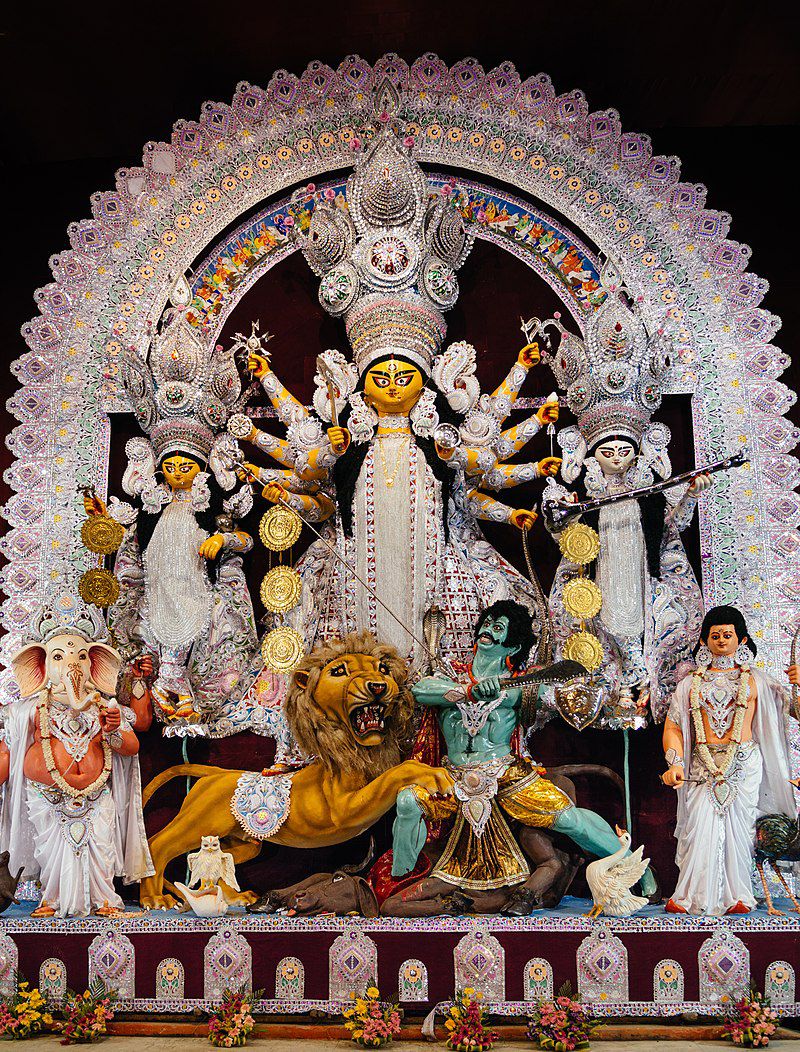
The primary goddess revered during Durga Puja is Durga but celebrations also include other major deities of Hinduism such as Lakshmi (the goddess of wealth and prosperity), Saraswati (the goddess of knowledge and music), Ganesha (the god of good beginnings), and Kartikeya (the god of war).
In Bengali and Odia traditions, these deities are considered to be Durga's children, and Durga Puja is believed to commemorate Durga's visit to her natal home with her beloved children.
The festival is preceded by Mahalaya, which is believed to mark the start of Durga's journey to her natal home.
Primary celebrations begin on the sixth day (Shasthi), on which the goddess is welcomed with rituals.
The festival ends on the tenth day (Vijaya Dashami) when devotees embark on a procession carrying the worshipped clay sculpture-idols to a river, or other water body, and immerse them, symbolic of her return to the divine cosmos and her marital home with Shiva in Kailash.
Regional and community variations in celebration of the festival and rituals observed exist.
Names:-
In West Bengal, Odisha, Assam, and Tripura, Durga puja is also called Akalbodhan (literally, "untimely awakening of Durga"), Sharadiya pujo ("autumnal worship"), Sharodotsab ("festival of autumn"), Maha pujo ("grand puja"), Maayer pujo ("worship of the Mother"), Durga pujo, or merely Puja or Pujo. In Bangladesh, Durga puja has historically been celebrated as Bhagabati puja.[citation needed] Maa Durga is known as the Goddess of Power (feminine) which represents triumph of Goodness over evil.
Durga puja is also referred to by the names of related Shakta Hindu festivals such as Navaratri, celebrated on the same days elsewhere in India; such as in Bihar, Jharkhand, Gujarat, Uttar Pradesh, Punjab, Kerala, and Maharashtra, Kullu dussehra, celebrated in Kullu Valley, Himachal Pradesh; Mysore dussehra celebrated in Mysore, Karnataka; Bommai golu, celebrated in Tamil Nadu; Bommala koluvu, celebrated in Andhra Pradesh;[E] and Bathukamma, celebrated in Telangana.
History and origins:-
Durga is an ancient deity of Hinduism according to available archeological and textual evidence. However, the origins of Durga puja are unclear and undocumented.
Durga puja is an old tradition of Hinduism, though its exact origins are unclear.
The prominence of Durga puja increased during the British Raj in the provinces of Bengal, Odisha and Assam.
However, in modern times, the importance of Durga puja is more as a social and cultural festival than a religious one, wherever it is observed.
Over the years, Durga puja has morphed into an inseparable part of Indian culture with a diverse group of people celebrating this festival in their unique way while on tradition.
Surviving manuscripts from the 14th-century provide guidelines for Durga puja, while historical records suggest the royalty and wealthy families to be sponsoring major Durga Puja public festivities, since at least the 16th-century.
The 11th or 12th-century Jain text Yasatilaka by Somadeva mentions an annual festival dedicated to a warrior goddess, celebrated by the king and his armed forces, and the description mirrors attributes of Durga puja.
(I didn't give the whole history cause if you've read Ramayana you'll know the "Akalbodhana" full rituals and it's freaking looog >~<)
Rituals and practices:-
Durga puja is a ten-day event, of which the last five days involve certain rituals and practices.
The festival begins with Mahalaya, a day on which Hindus perform tarpana by offering water and food to their dead ancestors.
The day also marks the advent of Durga from her mythological marital home in Kailash.
The next significant day of the festival is the sixth day (Sashthi), on which devotees welcomes the goddess and festive celebrations are inaugurated.
On the seventh day (Saptami), eighth (Ashtami) and ninth (Navami) days, the goddess along with Lakshmi, Saraswati, Ganesha, and Kartikeya are revered and these days mark the main days of worship with recitation of scriptures, puja, legends of Durga in Devi Mahatmya, social visits to elaborately decorated and illuminated pandals (temporary structures meant for hosting the puja), among others.
The rituals before the puja begins include the following:
Paata Puja: The process of making an idol usually begins with 'Paata Puja', on the day of the Rath Yatra that usually takes place around July.
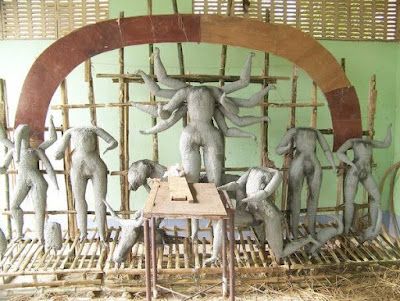
(Structure of a Durga sculpture-idol being made at Kumortuli)
Bodhana: Involves rites to awaken and welcome the goddess to be a guest, typically done on the sixth day of the festival.
Adhivasa: Anointing ritual wherein symbolic offerings are made to Durga.
Navapatrika snan: Bathing of the navapatrika with holy water.
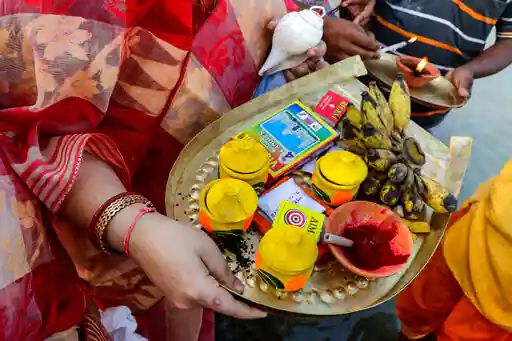
(Lady carrying offerings for the puja)
Sandhi puja and Ashtami pushpanjali: The eighth day begins with elaborate pushpanjali rituals. The sandhi puja, involving the offering of 108 lotuses and lighting if 108 lamps.
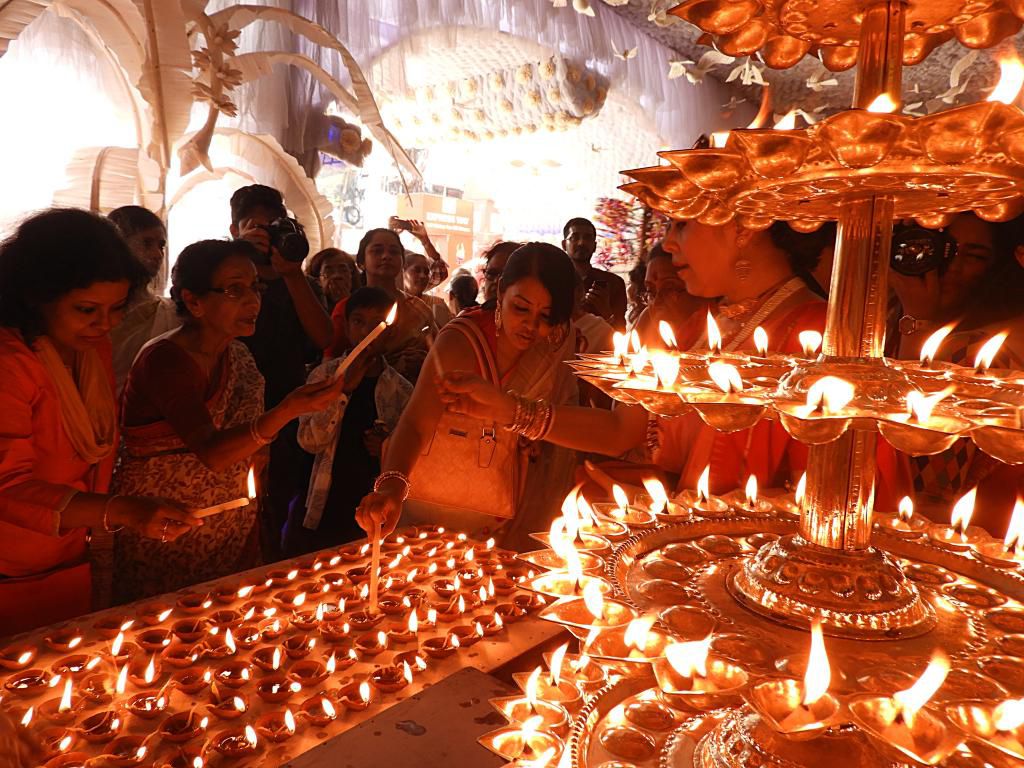
(Sandhi puja on the day of Ashtami)
Homa and bhog: The ninth day of festival is marked with the homa (fire oblation) rituals and bhog. Some places also perform kumari puja on this day.
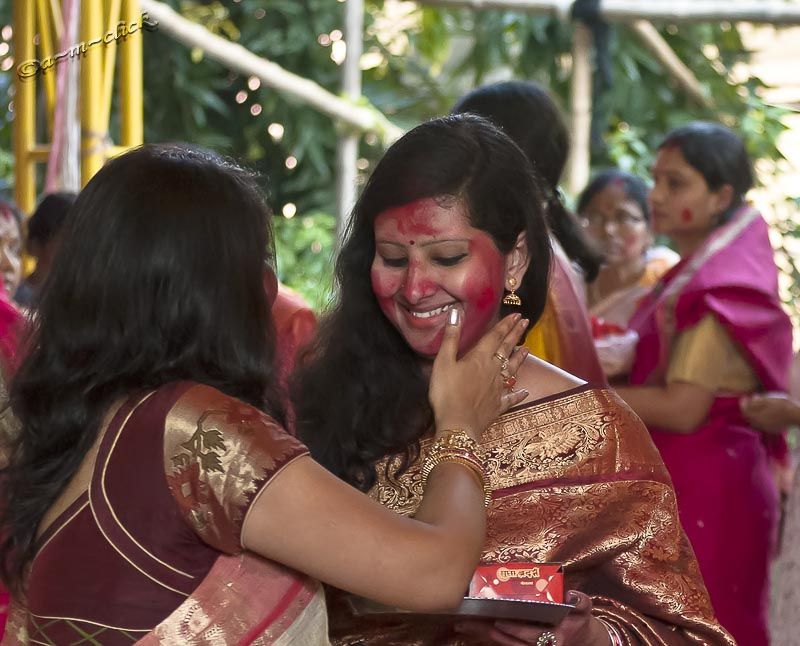
(Women taking part in sindoor khela on Vijaya Dashami)
Sindoor khela and immersion: The tenth and last day, called Vijaya dashami is marked by sindoor khela, where women smear sindoor or vermillion on the sculpture-idols and also smear each other with it. The tenth day is the day when Durga emerged victorious against Mahishasura and it ends with a procession where the clay sculpture-idols are ceremoniously taken to a river or coast for immersion rites. Following the immersion, Durga is believed to return to her mythological marital home of Kailasha to Shiva and the cosmos in general. People distribute sweets and gifts, visit their friends and family members on the tenth day.
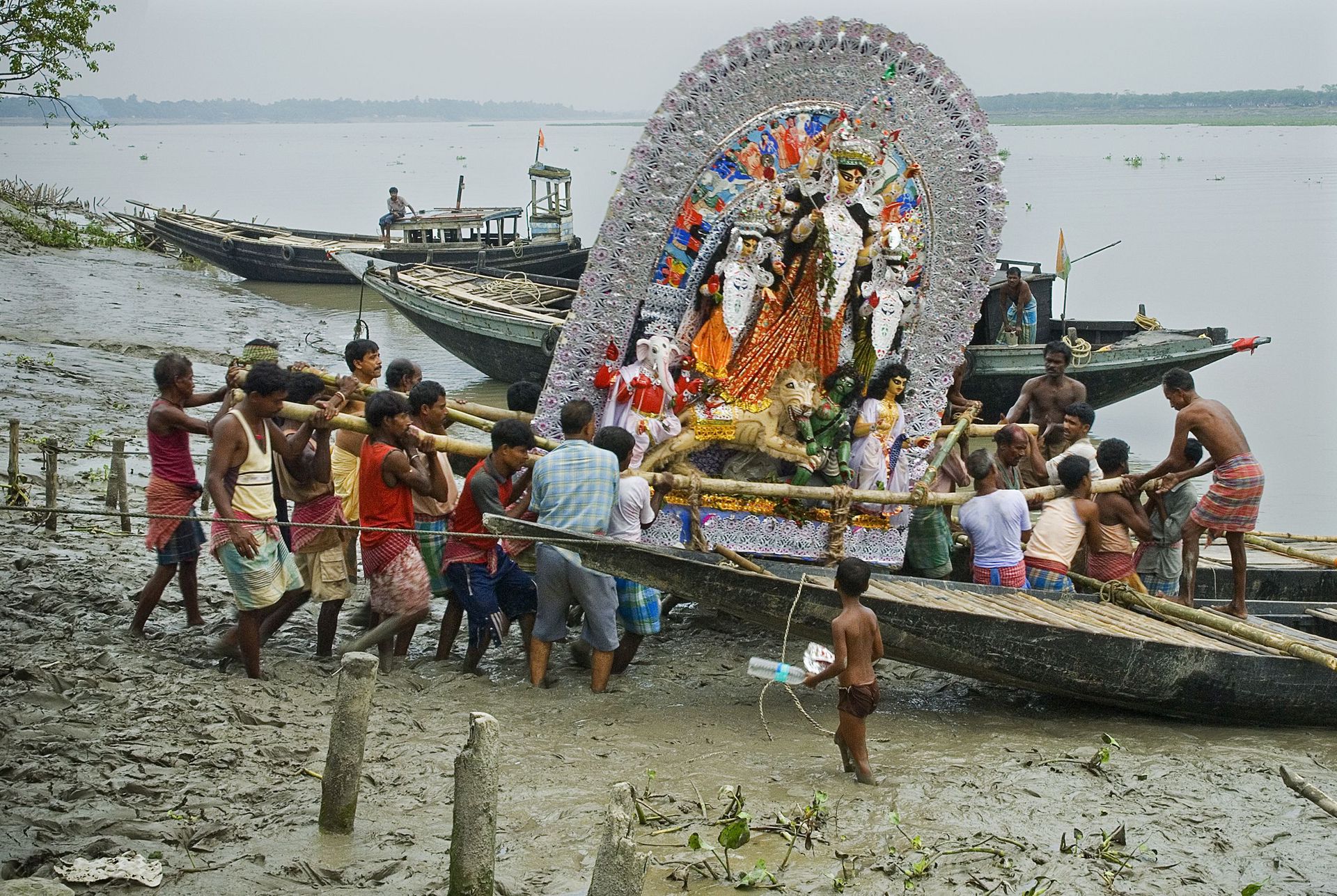
(Immersion of the sculpture-idol on Vijaya Dashami)

(Dhunuchi naach on Navami)
Dhunuchi naach: Dhunuchi naach involves a dance ritual performed with dhunuchi (incense burner). Drummers called dhakis, carrying large leather-strung dhaks create music, to which people dance either during or not during aarati.
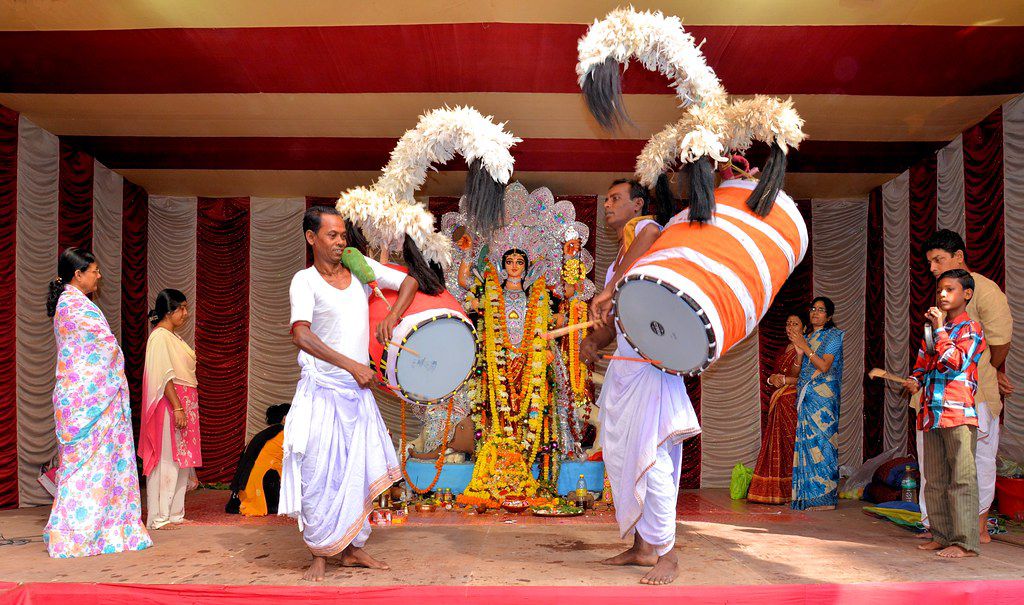
(Dhaks, played during the pujo)
Decorations and sculptures:-
The process of the creation of clay sculpture-idols (pratima or murti) for the puja, from the collection of clay to the ornamentation is a ceremonial process.
Though the festival is observed post-monsoon harvest, the artisans begin making the sculpture-idols months before, during summer.
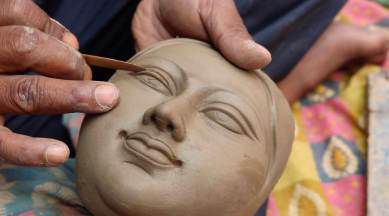
(A craftsperson sculpting the face of the sculpture-idol)
Pandals and theme-based pujas:-
Months before the start of Durga Puja, youth members of the community collect funds and donations, engage priests and artisans, buy votive materials and help build pandals centered around a theme, which has rose to prominence in recent years.
Such themes have included celebration of humanity, folk culture, celebration of cinema, pro-environment themes, while others have chosen metaphorical themes such as celebration of maati (literally, soil or ash) and "finding one's own light".

(Durga puja pandal decorations in Kolkata)
The process begins with prayers to Ganesha and to the perceived divinity in materials such as bamboo frames in which the sculpture-idols are cast.
Pandals have also been replicated on existing temples, structures, and monuments and yet others have been made of elements such as metal scraps, nails, and turmeric among others.
Durga puja pandals have also been centered around themes to acknowledge political events such as the 2019 Balakot airstrike and to protest against the National Register of Citizens of India.
The budget required for such theme-based pujas is significantly higher than traditional pujas.
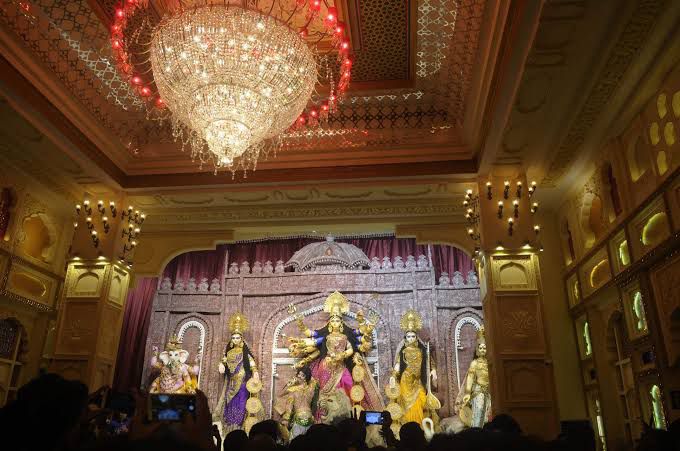
(Interior decorations of a pandal)
For such theme-based pujas, the preparations and the building of pandals are a significant arts-related economic activity, often attracting major sponsors.
Such commercialized pujas attract crowds of visitors. The growth of competitiveness in theme-based pandals has escalated costs and scale of Durga puja in eastern states of India.
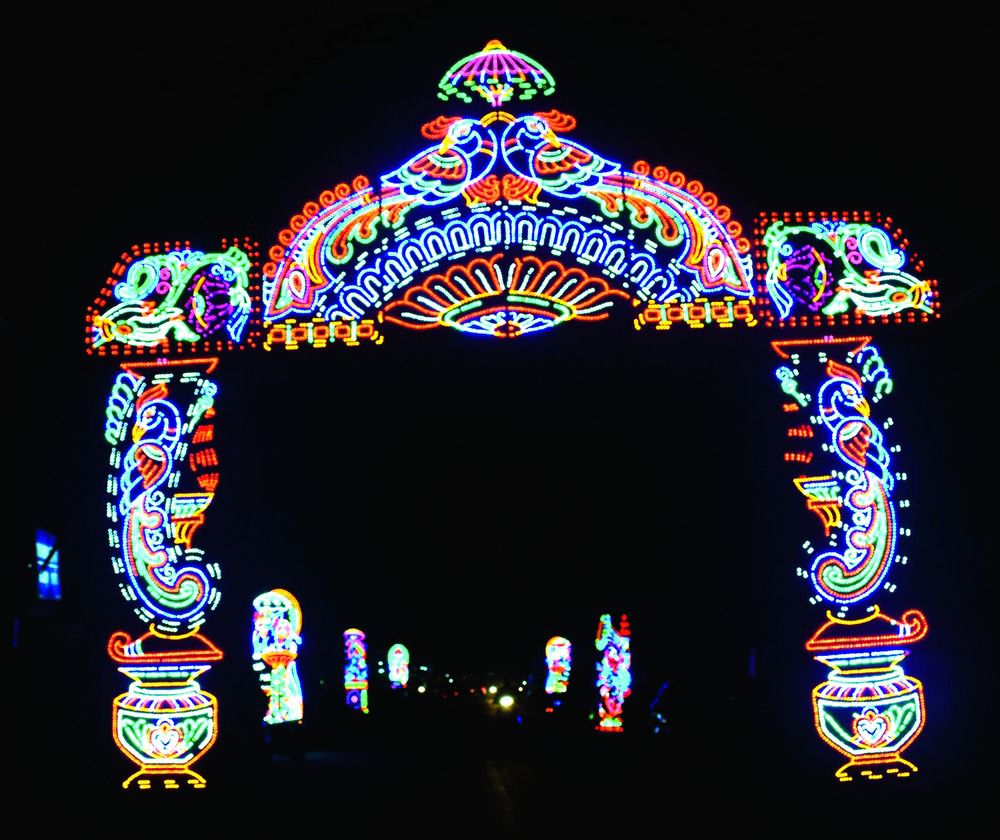
(Street lights installed during the festivities)
Some segments of the society criticize the billboards, the economic competition, and seek return to basics.
The competition takes many forms, such as the height of statue. In 2015, an 88-foot statue of Durga in Kolkata's Deshapriya Park attracted numerous devotees, with some estimates placing visitors at one million.
Regional celebrations and observances:-
There exists variation in worship practices and rituals associated with Durga puja, as is the case with other Hindu festivals, in the Indian subcontinent.
Hinduism accepts flexibility and leaves the set of practices to the choice of the individuals concerned.
Different localized rituals may be observed regionally, with these variations accepted across temples, pandals, and within families.
The festival is most commonly associated with Bengali Hindus, and with the community having variability and differences in practices.
There may exist differences of practice between the puja of theme-based Pandals, family pujas (with puja of erstwhile aristocrat families known as bonedi puja), and community pujas (known as barowari pujas) of neighbourhoods or apartments.
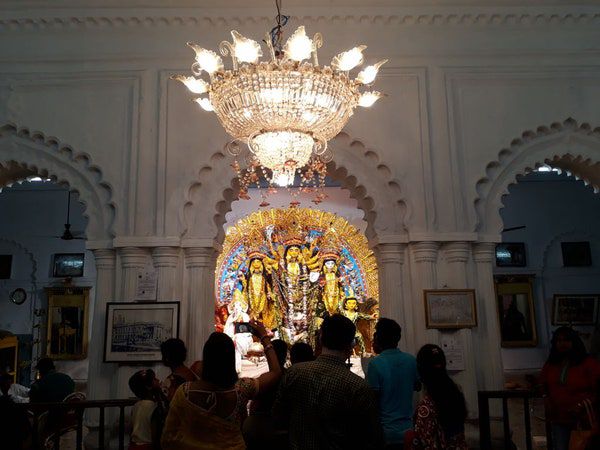
(Durga puja at the Shobhabazar Rajbari, in Kolkata, example of a bonedi puja)
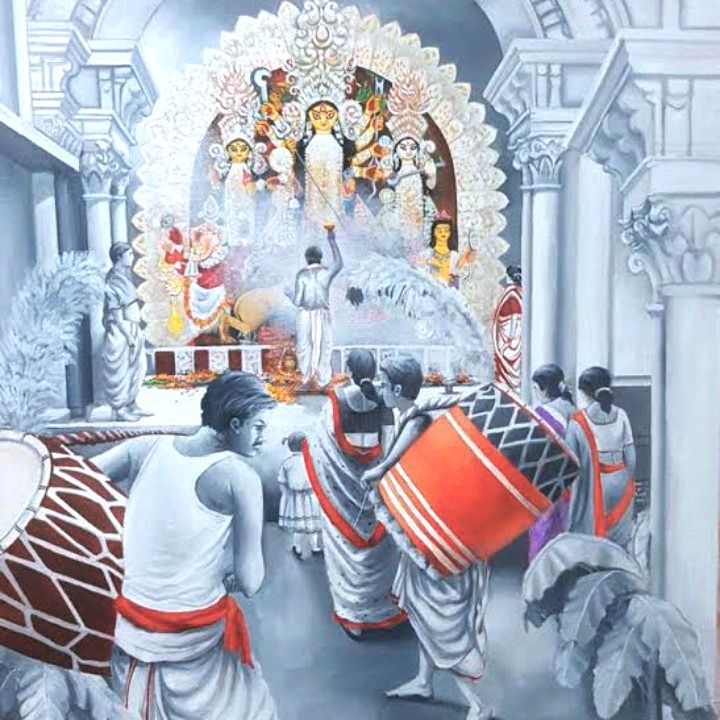
(Durga puja at Bagbajar, Kolkata, example of a sarvajanin barowari puja)
Durga puja is a widely celebrated festival in the Indian states of West Bengal, Bihar, Assam, and Odisha.
It is celebrated over a five-day period. Streets are decked up with festive lights, loudspeakers play festive songs as well as recitation of hymns and chants by priests, and pandals are erected by communities.
The roads become overcrowded with revellers, devotees, and pandal-hoppers visiting the pandals on puja days. It often creates chaotic traffic conditions.
Shops, eateries, and restaurants stay open all night; fairs are also set up and cultural programmes are held.
People form organizing committees, which plan and oversee the pandal during the festivities.
Today, Durga Puja has turned into a consumerist social carnival, a major public spectacle and a major arts event riding on the wave of commercialisation, corporate sponsorship, and craze for award-winning.
For private domestic pujas, families dedicate an area of their homes, known as thakur dalan, for Durga puja where the sculpture-idols for worship is placed and decorated with home-dyed fabric, sola ornamentations, and gold and silver foil decorations.
Elaborate rituals like arati are performed and prasad is distributed after being offered to the deities.
As a tradition, married daughters visit their parents and celebrate the Durga puja with them, a symbolism alluding to Durga who is popularly believed to return to her natal home during the puja.
Durga Puja is also a gift-giving and shopping season for communities celebrating it, with people buying gifts for not only family members but also for close relatives and friends.
New clothes are the traditional gift, and people wear them to go out together during Durga puja.
During puja holidays, people may also go to places of tourist attractions while others return home to spend Durga puja with their family.
It's a common trend amongst youngsters and even those who are older to go pandal-hopping and enjoy the celebrations.
The organising committees of each puja pandal hires a purohita (priest) who performs the puja rituals on behalf of the community.
For the priests, Durga puja is a time of activity wherein he pursues the timely completion of Vedic-Puranic-Tantric ritual sequences to make various offerings and perform fire oblations, in full public view, while the socio-cultural festivities occur in parallel.
The complex puja rituals include periods of accurate and melodic scripture recitation.
The puja involves crowds of people visiting the pandals, with smaller groups visiting family pujas, to witness the celebrations.
On the last day, the sculpture-idols are carried out in immersion processions across Bengal, following which they are ritually immersed into rivers or other waterbodies.
The immersion ceremony continues till a couple of days after the last day of puja.
Media attention:-
Durga puja has been a theme in various artistic works such as movies, paintings, and literature.
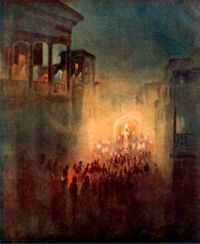
The day of Mahalaya is marked by the Bengali community with Mahishasuramardini - a two-hours long All India Radio program - that has been popular in the Bengali community since the 1950s.
While in earlier days it used to be recorded live, a pre-recorded version has come to be broadcast in recent decades.
Bengalis traditionally wake up at four in the morning on Mahalaya to listen to the radio show, primarily involving recitations of chants and hymns from Devi Mahatmyam (or Chandi Path) by Birendra Krishna Bhadra and Pankaj Kumar Mullick. The show also features various devotional melodies.
Dramas enacting the legend of Durga slaying Mahishasura are telecasted on the television.
Radio and television channels also air other festive shows, while Bengali and Odia magazines publish special editions for the puja known as Pujabarshiki (Annual Puja Edition) or Sharadiya Sankhya (Autumnal Volume).
These contain works of writers, both established and upcoming, and are more voluminous than the regular issues.
Some notable examples of such magazines in Bengali are Anandamela, Shuktara, Desh, Sananda, Nabakallol, and Bartaman.
Durga Puja Celebrations outside of India:-
In the Netherlands, the puja is celebrated in places such as Amstelveen, Eindhoven, and Voorschoten.
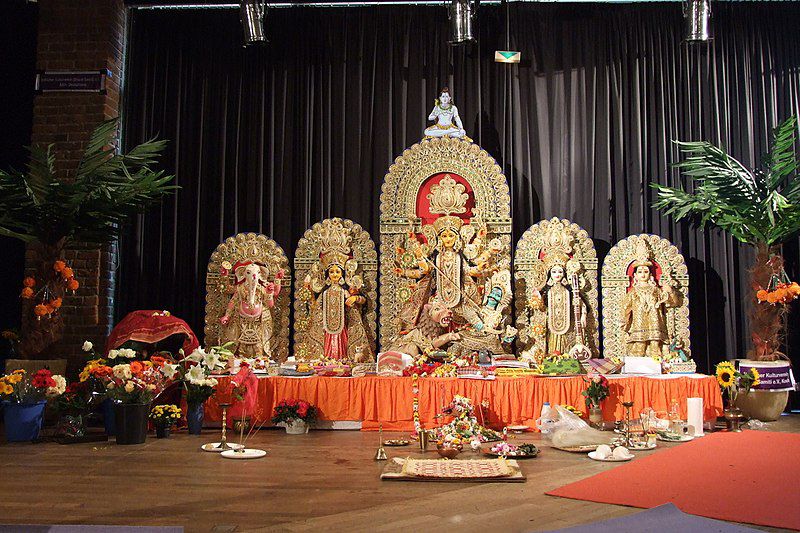
(Durga puja in the Netherlands, in 2017)
Durga puja is celebrated commonly by Bangladesh's Hindu community. Some Bengali Muslims also take part in the festivities.
In Dhaka, the Dhakeshwari Temple puja attracts visitors and devotees. In Nepal, the festivities are celebrated as Dashain.
Beyond south Asia, Durga puja is organized by Bengali communities in the United States of America.
In Canada, Bengali Hindu communities both from Bangladesh and West Bengal, India organise several Durga pujas.
Greater Toronto Area has the most number of Durga Puja celebration venues organized by different Bengali cultural groups such as Bangladesh Canada Hindu Cultural Society (BCHCS), Bongo Poribar Sociocultural Association etc.
According to BBC News, for community celebrations in London in 2006, these "Idols, belonging to a tableau measuring 18ft by 20ft, were made from clay, straw and vegetable dyes".
At the end of the puja, the sculpture-idols were immersed in River Thames for the first time in 2006, after "The community was allowed to give a traditional send-off to the deities by London's port authorities".
In Germany, the puja is celebrated in Cologne, and other cities. In Switzerland, puja in Baden, Aargau has been celebrated since 2003.
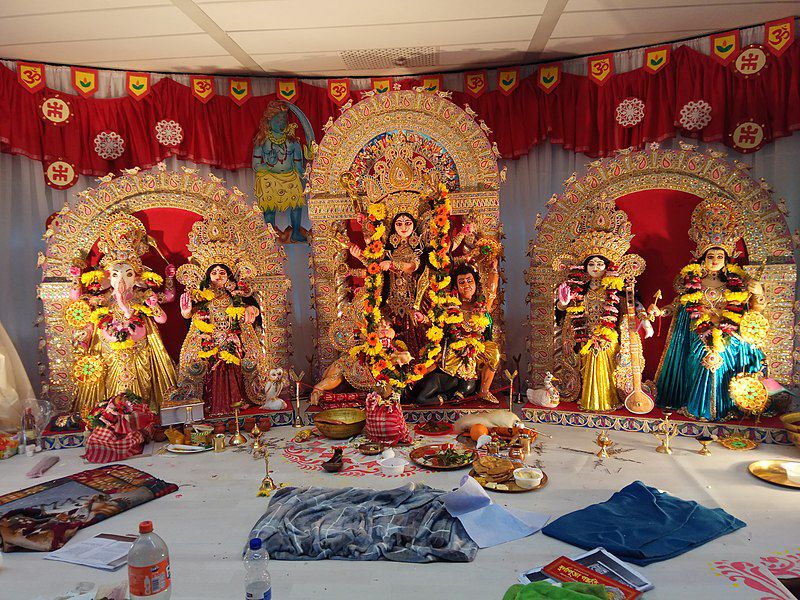
(Durga puja in Germany, in 2009)
Now pictures taken by Me :)
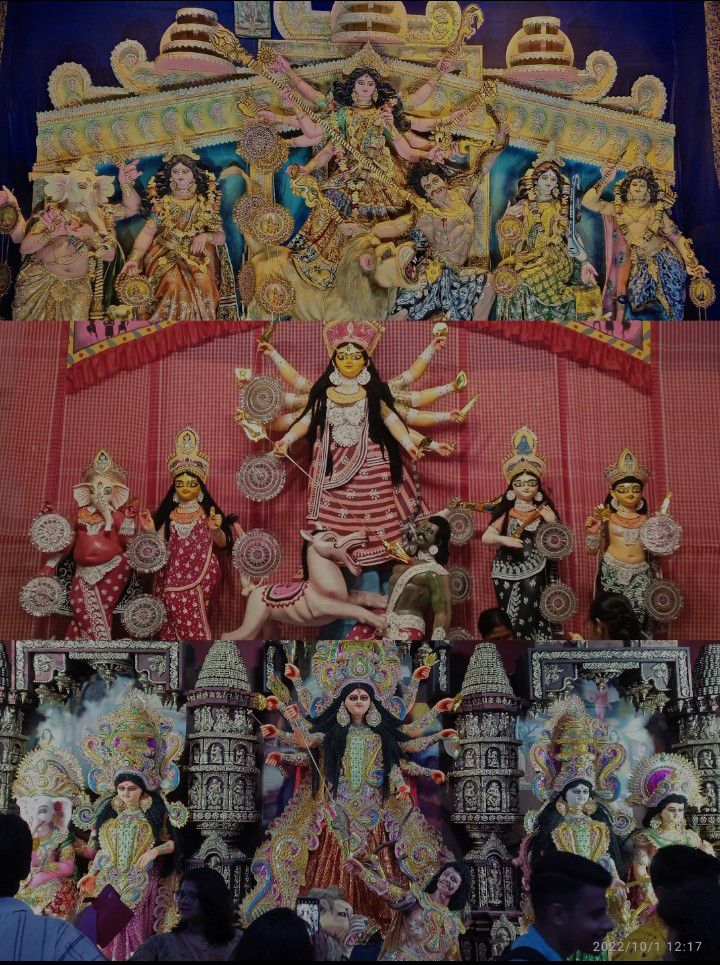
Dang Wattpad can't let me put the original quality because of over 3 MB >:(
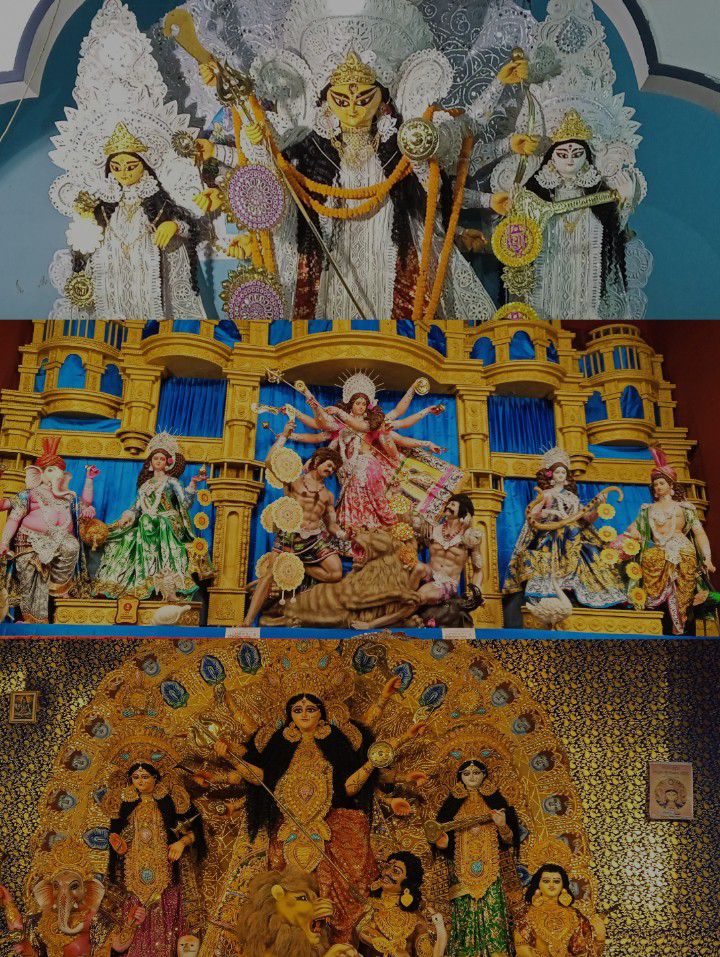
Well I can't do anything :(
So that's it :) See You ❤️✨
~ Rose 🌹✨ Out 💙
Bạn đang đọc truyện trên: Truyen247.Pro